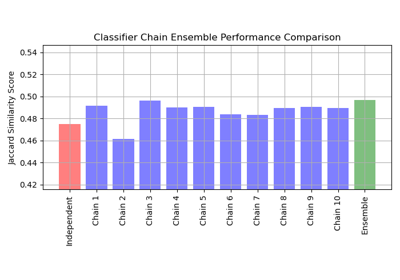sklearn.multioutput.ClassifierChain¶
-
class
sklearn.multioutput.ClassifierChain(base_estimator, *, order=None, cv=None, random_state=None)[source]¶ A multi-label model that arranges binary classifiers into a chain.
Each model makes a prediction in the order specified by the chain using all of the available features provided to the model plus the predictions of models that are earlier in the chain.
Read more in the User Guide.
New in version 0.19.
- Parameters
- base_estimatorestimator
The base estimator from which the classifier chain is built.
- orderarray-like of shape (n_outputs,) or ‘random’, optional
By default the order will be determined by the order of columns in the label matrix Y.:
order = [0, 1, 2, ..., Y.shape[1] - 1]
The order of the chain can be explicitly set by providing a list of integers. For example, for a chain of length 5.:
order = [1, 3, 2, 4, 0]
means that the first model in the chain will make predictions for column 1 in the Y matrix, the second model will make predictions for column 3, etc.
If order is ‘random’ a random ordering will be used.
- cvint, cross-validation generator or an iterable, optional (default=None)
Determines whether to use cross validated predictions or true labels for the results of previous estimators in the chain. If cv is None the true labels are used when fitting. Otherwise possible inputs for cv are:
integer, to specify the number of folds in a (Stratified)KFold,
An iterable yielding (train, test) splits as arrays of indices.
- random_stateint, RandomState instance or None, optional (default=None)
If
order='random', determines random number generation for the chain order. In addition, it controls the random seed given at eachbase_estimatorat each chaining iteration. Thus, it is only used whenbase_estimatorexposes arandom_state. Pass an int for reproducible output across multiple function calls. See Glossary.
- Attributes
- classes_list
A list of arrays of length
len(estimators_)containing the class labels for each estimator in the chain.- estimators_list
A list of clones of base_estimator.
- order_list
The order of labels in the classifier chain.
See also
RegressorChainEquivalent for regression
MultioutputClassifierClassifies each output independently rather than chaining.
References
Jesse Read, Bernhard Pfahringer, Geoff Holmes, Eibe Frank, “Classifier Chains for Multi-label Classification”, 2009.
Methods
Evaluate the decision_function of the models in the chain.
fit(X, Y)Fit the model to data matrix X and targets Y.
get_params([deep])Get parameters for this estimator.
predict(X)Predict on the data matrix X using the ClassifierChain model.
Predict probability estimates.
score(X, y[, sample_weight])Return the mean accuracy on the given test data and labels.
set_params(**params)Set the parameters of this estimator.
-
__init__(base_estimator, *, order=None, cv=None, random_state=None)[source]¶ Initialize self. See help(type(self)) for accurate signature.
-
decision_function(X)[source]¶ Evaluate the decision_function of the models in the chain.
- Parameters
- Xarray-like, shape (n_samples, n_features)
- Returns
- Y_decisionarray-like, shape (n_samples, n_classes )
Returns the decision function of the sample for each model in the chain.
-
fit(X, Y)[source]¶ Fit the model to data matrix X and targets Y.
- Parameters
- X{array-like, sparse matrix}, shape (n_samples, n_features)
The input data.
- Yarray-like, shape (n_samples, n_classes)
The target values.
- Returns
- selfobject
-
get_params(deep=True)[source]¶ Get parameters for this estimator.
- Parameters
- deepbool, default=True
If True, will return the parameters for this estimator and contained subobjects that are estimators.
- Returns
- paramsmapping of string to any
Parameter names mapped to their values.
-
predict(X)[source]¶ Predict on the data matrix X using the ClassifierChain model.
- Parameters
- X{array-like, sparse matrix}, shape (n_samples, n_features)
The input data.
- Returns
- Y_predarray-like, shape (n_samples, n_classes)
The predicted values.
-
predict_proba(X)[source]¶ Predict probability estimates.
- Parameters
- X{array-like, sparse matrix}, shape (n_samples, n_features)
- Returns
- Y_probarray-like, shape (n_samples, n_classes)
-
score(X, y, sample_weight=None)[source]¶ Return the mean accuracy on the given test data and labels.
In multi-label classification, this is the subset accuracy which is a harsh metric since you require for each sample that each label set be correctly predicted.
- Parameters
- Xarray-like of shape (n_samples, n_features)
Test samples.
- yarray-like of shape (n_samples,) or (n_samples, n_outputs)
True labels for X.
- sample_weightarray-like of shape (n_samples,), default=None
Sample weights.
- Returns
- scorefloat
Mean accuracy of self.predict(X) wrt. y.
-
set_params(**params)[source]¶ Set the parameters of this estimator.
The method works on simple estimators as well as on nested objects (such as pipelines). The latter have parameters of the form
<component>__<parameter>so that it’s possible to update each component of a nested object.- Parameters
- **paramsdict
Estimator parameters.
- Returns
- selfobject
Estimator instance.

